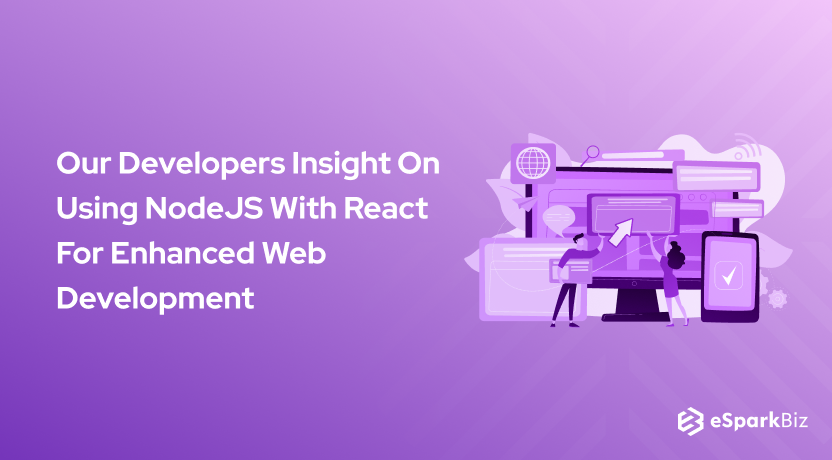To achieve this, a lot of them have started using a well-known JavaScript environment like NodeJS with React to build robust web applications.
NodeJS for Enterprise Application is also a reality. So, why not NodeJS and ReactJS be used as a combination.
Now, if you are also looking forward to using NodeJS and ReactJS together, then some of the questions that might appear in your mind are,
- Can Node.js be used with the React?
- Can we need Node.js in the Backend with React?
- How does React and Node Fit well for a Web Application Development
To help you out, we have created a detailed guide with our expert developer’s support in order to clarify all the above questions, besides some other important questions that you should consider while developing web applications using NodeJS with React.
Also, you will find essential reasons to use NodeJS with React.
But, before we move ahead, let’s have a basic introduction of ReactJS and NodeJS.
What Is ReactJS: Pros and Cons
ReactJS is not a framework but one of the leading JavaScript libraries. It is released and maintained by Facebook as well as by various developers and companies.
It works according to the MVC architecture and updates all the things in the View part of the architecture. Moreover, ReactJS is widely useful for building attractive user interfaces.
It more or less provides solutions of issues that occur during the rendering of large databases.
Pros and Cons of ReactJS
Pros of ReactJS
- ReactJS is quite handy because it offers in-depth documentation along with a wide range of tutorials and resources to kickstart your learning.
- Moreover, a developer familiar with JavaScript can begin working with ReactJS within a couple of days.
- ReactJS has enhanced the process of developing dynamic web applications. Earlier, doing this thing via HTML strings was extremely difficult.
- But now, ReactJS has streamlined the entire method. By utilizing the browser extension, you can integrate HTML quotes, syntax into the code.
- ReactJS allows developers to use numerous components for making web applications. These components possess specific logic & functionality. All these components throw a minor HTML code that can be used again & again in the web application development. Moreover, reusable code simplifies the entire process of development & maintenance.
- ReactJS speeds up the performance because of Virtual DOM. Here, DOM is a cross-platform programming API that looks after HTML, XML, or XHTML.
- Earlier, when DOM was updated, it dropped the performance. This problem got solved with the release of Virtual DOM. It resides inside the memory and it’s a depiction of the web browser’s DOM.
- As compared to various other JS frameworks, ReactJS is SEO-friendly. Various search engines are not able to read JS’-heavy applications properly.
- But, ReactJS resolves this issue as it operates applications on server & the virtual DOM is rendering and returning to the browser as a normal web page.
Cons of ReactJS
- Fast-paced development sometimes aids and often it’s a significant obstacle. Here, the main drawback is that a quickly updating environment makes it highly challenging for developers to learn and implement new things in web applications.
- One of the other major drawbacks of ReactJS is poor documentation. As it is continuously modifying technologies, it’s become hard to make in-depth documentation.
- React just looks after the View part in the entire procedure of app development. Therefore, you have to opt for some different technologies to build other parts.
- ReactJS consists of a JSX, an extension that utilizes HTML along with the JavaScript.This method possesses its own pros, yet various developers think of it as an obstacle in the learning curve.
What Is NodeJS: Pros and Cons
NodeJS is mainly a JavaScript runtime environment that is built on the Chrome V8’s Engine. It is a bundle that consists of all the things needed to run a program in JavaScript.
NodeJS launched the callback concept to achieve the app-idea of event-driven single-threaded server programming and further builds JS on the server-side. Moreover, it enhances the process of building web applications.
Pros and Cons of NodeJS
Pros of NodeJs
- js provides enhanced scalability as compared to any other JavaScript servers. How? It allows developers to scale in the horizontal and vertical directions.
- To scale horizontally, one needs to include new nodes into the current system. To scale vertically, a developer can integrate various resources into the single nodes.
- JavaScript language is well-known all around the world & NodeJS is originated from it. Hence, the majority of developers having good command over front-end can instantly learn back-end with Node.js and start implementing in their projects.
- It is considered a full-stack JavaScript framework; hence, it can be used for client-side and server-side applications.
- JS offers top-notch performance due to Chrome’s V8 JavaScript Engine, which instantly compiles the JavaScript code into the machine code.
- Hence, it allows developers to implement code efficiently. Also, code execution happens rapidly due to a runtime environment backed up by non-blocking I/O operations.
Cons of NodeJS
- NodeJS developers face issues with its highly-unstable API. From time to time, a new API appears consisting of backward-incompatible changes. Hence, you can hire Node.js developers to update it as per the latest version of Node.js to match its compatibility.
- NodeJS doesn’t possess a well-equipped library system when we compare it with other programming languages. Hence, developers have to use various common libraries for things like ORM, processing images, etc.
- Even though the asynchronous programming model is required for scalability, various developers find it challenging to work compared to linear blocking I/O programming.
- Also, code written in asynchronous programming is awkward; hence developers are forced to use nested calls.
Is React Front-End or Back-End Library?
React is a front-end library that is developed and maintained by Facebook from 2015. Like other libraries, it works well with any old web server such as Apache, NGINX, or using backend such as PHP, Ruby on Rails, etc.
It consists of a React DOM library that works efficiently with the web browser’s DOM. Later, it got upgraded to a cross-platform framework known as React Native, which is now used to build native-like apps for Android and iOS platforms.
Using React, it is possible to develop a web app that resolves all the issues of bad user interactions and performance because of its DOM manipulations.
This happens with Virtual DOM, which monitors changes regularly and scrutinizes an algorithm to identify the notable points between the two UI states.
Is Node.js Front-End or Back-End?
As per the latest Node.js survey, above 43% of developers agreed that they use Node.js for enterprise development, as it is the best choice for developing trending solutions related to microservices, WebSockets, and event queries.
It’s a preferred choice for back-end more due to some essential reasons like an asynchronous model, non-blocking I/O, and event-driven architecture.
Moreover, its JavaScript runtime environment gives developers the freedom to run documents that aren’t executed in the web browser; hence, it is a widely used back-end environment.
Some of the leading tech giants around the world like Amazon, Netflix, PayPal, Walmart, etc., use Node.js for back-end development.
Node.js consists of an important feature that allows automatizing routine tasks, including testing of code, tool kit, etc., that is available under the front-end environment. Briefly, Node.js can be used for both front-end as well as back-end development.
Due to its scalability and huge developer community, Node.js is the first option for front-end development.
Why Use NodeJS With React in 2024?
Without any doubt, Node.js is the most suitable platform for hosting and running a web server for a React application.
Due to the two most important reasons, you can use React JS and Node JS together:
- With the help of NPM (Node Package Manager), Node works appropriately with the NPM registry to quickly install any package via the NPM CLI.
- Node puts together a React application into one file for quick compilation via webpack and other Node modules.
Moreover, utilizing Node.js to host and run your web server is beneficial in various ways as given below:
- js consists of a highly optimized V8 engine to consider bulk requests fully managed by callback functions to provide the best quality and quantity.
- js and React.js are javascript languages that are handled through the client and server-side.
- Developers have the freedom to operate Reactjs code instantly in the Nodejs environment.
- React DOM consists of components that work efficiently with Nodejs, which decreases the overall programming, which in turn makes server-side rendering simple & effective.
Do You Need Node.js In Back-End To Run React?
Various developers think that for running React.js, they have to compulsorily use Node.js. But in reality, that’s not the case every time.
We know that React.js is a library and is well known for providing various user interfaces for the web and mobile apps.
In contrast, Node.js is a JavaScript runtime environment useful to manage communication on the server-side. It’s widely utilized in networking applications to offer real-time data management across systems.
Here, Reactjs is highly useful in developing UI components on the front end; however, Nodejs manages the data on the back end.
Far better, various popular tools such as react-router and redux can be utilized to make communication better at the server-side offered by Node.js.
This whole process enhances communication from one-end to another. Like, whenever a user engages with UI and a server request is generated, the browser provides relevant data from the backend.
Here is a summary of how Node JS and React can be used together: Reactjs functioning as a front-end framework, bundles all the components present to the particular routes.
Whilst, Node.js, which is a backend framework, doesn’t think much about the element that loads the specific URL. It’s just offering the environment for the entire data communication.
Reasons To Use NodeJS With React
Yes, there are some of the most remarkable benefits of using React NodeJS together. When you hire ReactJS Developer, they can combine React with Node JS that can help you to decrease overall development time along with some other awesome benefits.
Here is the list of reasons you should consider using ReactJS and NodeJS for your next development project:
High Server Load
Utilizing Node JS and React is beneficial for a web application that requires various requests and keeping server load balance.
Real-Time Data
In case your app’s basic part relies on the real-time data-intensive management or Data Streaming, integrating Node.js is the best choice for efficient server connection.
JSON APIs
Developing JSON APIs for your web app is effective because of high code reusability and instant code sharing in React.js.
Single Page Applications (SPA)
Building single-page applications in React and using Node to create a lightweight back-end model for asynchronous data loading via callback functions.
MERN Stack
Nodejs can also be utilized with MERN (MongoDB, Express, React, and Nodejs) stack.
How Do React and Node Fit Together?
Consider that we are developing a new Blog with the CRUD (create, read, update, and delete) functionalities and consists of some lists of blog posts, contact us, and blog posts details page.
For this, we will use Node/ Express for the backend and React for the frontend.
Here, React will only modify the view part of the frontend. However, we also need to update the data coming from the backend API and enable routing. To achieve this, we have to use React router and Redux.
If you don’t want to use Redux, you will require three separate containers, mainly a list of blog posts, contact us, and blog post details. Every container consists of its own data that not shared with any of the other containers.
How does it work?
Here, we will utilize express that’s basically the framework of NodeJS.
Express allows us to create routes for all the pages required. Therefore, here we will have a
homepage ( list of blog posts ) at path=’/‘, details of a blog post at path=‘/:id’ and contact us at path=‘/contact’
All the route we define consists of two parameters, mainly request and response and also consists of a callback function.
app.get(‘/’, function(req, res) {
res.send(‘Hello World’)
})
Anytime a user visits the URL mapped to the path= ‘/’, a request sent to the server, and the server replies using the callback function. Within this callback function, we can write our logic.
In the same way, we can write functions for various paths.
app.get(‘/:id’, function(req, res) {
res.send(‘New Post’)
})
Where does React fit well in the picture?
React looks after the frontend of the app. Anytime a new user visits the path = “/,” a query transferred to the express server, which answers with a response to the browser.
Here in the frontend, we possess routers mapped to look after the response coming from various routers and display the data.
You need routers in the frontend to load all the proper components for every path because the backend server remains neutral if any component loaded when the user visits the path = ‘/.’ It possesses all the details about the type of data to send when users visit a specific path.
The react-router only maps a path to the component.
<Route path=‘/‘ component={Homepage} />
<Route path=‘/contact‘ component={Contact} />
Anytime we visit the path = ‘/’, the homepage component will load.
As soon as we obtain data from a server in the form of JSON, we would display a list of blog posts.You can achieve it using a container in React (like Homepage container).
A component is mainly a class or function that narrates part of the React UI. In comparison, a container is only a component that has power over all the state and lifecycle ways.
In the Homepage container, we can form a function that processes all elements via JSON and builds a list of posts. It’s basically a standard HTML page; however, written in JSX.
You can store server-side data in any database (MongoDB, firebase).
Lastly, that’s the main point of integrating Express in backend and the React in frontend.
Read also: Step-by-Step Guide To Use React With Redux
Why Combination Of Node.js & React An Ideal One?
The majority of developers love to utilize the combination of ReactJS and NodeJS to build reusable user interface modules. Node and ReactJS is a great combination in the long run.
React is a JavaScript library that used to serve the view component of the MVC architecture. It is a JavaScript virtual DOM because it is quicker as compared to other DOMs.
Despite the fact that ReactJS is particularly for browser, various ReactJS development firms utilize it to render a server accessing the combination of Node.js.
Here, the data & the modules are perfect for handling vast applications and enhancing readability across multiple devices.
Conclusion
From the above points, we can say that a combination of React with Node JS can do wonders for your web development project. For this, you first need to be familiar with NPM & implement it in your project to take it to the next level.
Whether you want to develop a new web application or update an existing one, you can approach us. We are a Node JS Development Company with years of experience building top-notch web apps for clients across the globe.


-
Can You Use Node.js With React?
The simple answer to this question would be YES. Node.js is the most suitable platform for hosting a react application.
-
Why Node Is Required For React?
When you’re using Node in your project, the scope becomes wider and you can get help from a variety of experts. Afterall, Node.js is Javascript.
-
How Do I Connect NodeJS and ReactJS?
There are some steps you need to follow for the Node-React connection. They are as listed follows:
- Setting up back-end using Express.js
- Using create-react-app to create a front-end
- Using Axios for cross API calls
- Handling POST requests
- Using express-fileupload
-
Is Redux Front-End or Back-End?
Pure redux comes for javascript applications. However, it can run in the back-end with the node.js, if you wish to.!
-
Is Node.js a front-end or back-end?
Node.js is a server-side runtime environment that allows us to develop back-end applications using Javascript.
-
What Is The Best Backend For React?
Express.js which is based on Node is the best backend for react.












